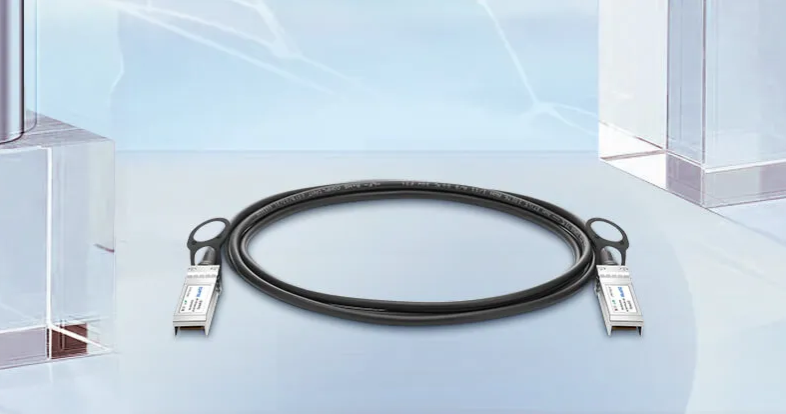

 Knowledge Base +
Knowledge Base +  2024.01.09
2024.01.09Direct Attach Copper (DAC) cables and Small Form-Factor Pluggable Plus (SFP+) are both technologies used in networking for high-speed data transmission, but they serve different purposes and have distinct characteristics. Here are the key differences between DAC and SFP+:
Connection Type:
DAC (Direct Attach Copper): DAC cables are copper-based cables with connectors on both ends, and they are typically used for short-distance connections within racks or between closely located network devices. DAC cables have fixed connectors (such as SFP+ or QSFP+) on both ends and are often pre-terminated for specific distances.
SFP+: SFP+ is a form factor for optical or copper transceivers. When referring to SFP+, it usually means the optical or copper transceiver module itself that can be plugged into SFP+ ports on networking equipment.
Construction and Medium:
DAC: DAC cables consist of copper conductors and connectors, making them cost-effective and suitable for short-distance connections. They can be passive (without electronics) or active (with built-in signal processing for longer distances).
SFP+: SFP+ refers to the transceiver form factor and can support various types of interfaces, including optical (using fiber optic cables) or copper (using Twinax cables for short distances).
Use Cases:
DAC: DAC cables are commonly used for short-distance connections within data centers, such as interconnecting switches and routers in the same rack or adjacent racks. They are cost-effective for these applications where high bandwidth is needed over short distances.
SFP+: SFP+ transceivers are versatile and can be used for various applications. They are commonly used for both short-distance (using DAC for cost-effectiveness) and long-distance (using fiber optics) connections, providing flexibility based on the network's requirements.
Flexibility and Reach:
DAC: DAC cables are fixed-length cables, and their reach is limited to the specific length for which they are designed. They are not as flexible for variable distances as optical transceivers.
SFP+: SFP+ transceivers offer more flexibility in terms of reach. Depending on the type of transceiver and the medium used (fiber optics or copper), SFP+ can support various distances.
In summary, DAC and SFP+ serve different purposes in networking. DAC cables are copper-based cables used for short-distance, cost-effective connections, while SFP+ refers to the form factor of transceiver modules that can support various media, including copper for short distances or fiber optics for longer distances.
Advantages of SFP+ Direct Attach Cable
SFP+ Direct Attach Copper cables is a modest, low power, and low-inactivity technique for in-rack 10Gbps associations among servers and switches. It has worked on electrical properties for the most reliable sign transmission and further developed organization links for high-thickness establishments. SFP+ cables have various outstanding advantages.

Figure : DAC 10G SFP+ cable manufactured
▪ MSA compatible — conforms to all SFP+ MSA requirements
▪ Reliability — RoHS compliant with good EMI performance and high reliability
▪ High speed — support 10 Gbps download speeds with reusability to 1 Gbps
▪ Space-saving — offer the lowest 10 gigabit form factor and a comparatively small cable diameter for greater density and optimized rack space in 10 Gigabit Ethernet uplinks and Fiber Channel
▪ Scalability and flexibility — provide enhanced flexibility and scalability, as well as greater density, for today’s data centers and storage area networks
▪ Cost-effectiveness — two to 3 times less expensive than fiber optic alternatives, with reduced latency and up to 50% less power consumption per port than conventional copper twisted-pair cable systems.
Types of SFP+ DAC (Direct Attach Cable)
SFP+ active copper cable (ACC) and SFP+ passive copper cable (PCC) are the two varieties of SFP+ direct attach cables (DAC). The SFP+ passive copper cable (PCC), also known as a passive SFP+ DAC, complies with the SFF-8431 SFP+ MSA. The cable arrangement has no signal intensity. Electronic dispersion compensation (EDC) is often used on host board designs when it is used. Passive cable assemblies can be made longer with EDC.
They allow active equipment with SFP+ ports to communicate at high speeds. Copper cable trunks are built to order, which cuts down on installation time and increases flexibility. Because of its low energy consumption, the active copper cable assemblage is a cost-effective solution for within-rack or rack-to-rack applications. Signal amplification and equalization are built into the SFP+ active copper cable (ACC). In host systems that do not use EDC, SFP+ ACC assemblies are commonly employed. They also have Rx LOS and Tx Disable capabilities.
The industry standard EEPROM signature, just like with passive cables, allows the hypervisor to distinguish between an active copper cable and a fiber optic transceiver. Short-range QSFP28 transceivers offer multimode fiber connections of up to 100 meters. This method is like using AOC cables, however, structured cabling could be used instead. They employ more expensive non-standard MPO (multi push-on/pull-off cable) connectors, negating some of the transceiver’s cost benefits.
Subscribe to the newsletter
for all the latest updates.
2-5# Building, Tongfuyu Industrial Zone, Aiqun Road, Shiyan Street, Baoan District, Shenzhen. China
